TEST 5: EGR Pintle Position Sensor Ground Circuit

You've reached this point because:
- In TEST 1, you verified that the EGR valve's passages in the intake plenum are not clogged.
- In TEST 2, you got a very low to 0 voltage reading on the wire labeled with the letter C (this is the EGR pintle position signal circuit).
- In TEST 4, your multimeter did register the 5 Volt Reference voltage that powers the pintle position sensor.
The next step is to check that the PCM is providing a good Ground for those 5 Volts.
If the PCM does not provide a Ground path, the EGR valve will not function and this test will help you to confirm this.
This is what you'll need to do:
- 1
Place your multimeter's selector in Volts DC mode.
- 2
Disconnect the EGR from it's electrical connector.
- 3
Probe the wire labeled with the letter B with the black multimeter test lead.
- 4
Connect the red multimeter test lead to the battery positive (+) terminal.
- 5
Turn the key ON (but engine OFF).
- 6
The multimeter should read between 10 to 12 Volts DC.
Let's take a look at what your test results mean:
CASE 1: Your multimeter displayed 10 to 12 Volts DC. This is the correct test result and it confirms that the EGR valve's pintle position sensor is receiving Ground.
You can conclude that the EGR valve is bad (and needs replacement) if you have confirmed that:
- The EGR valve's exhaust passage (in the intake manifold plenum) is not blocked (TEST 1).
- The EGR valve is not producing the correct pintle position value (TEST 2).
- The EGR valve's pintle position sensor is getting 5 Volts (TEST 4).
- The EGR valve's pintle position sensor is getting Ground (in this test section).
Here's why: The EGR valve's pintle position sensor is receiving power and Ground. With these two inputs, it has to produce a pintle position sensor signal to the PCM. Since it isn't, you can conclude that it's faulty.
CASE 2: Your multimeter DID NOT display 10 to 12 Volts DC. This result exonerates the EGR valve itself as bad since without a Ground path for the EGR pintle position sensor, the EGR valve will not function correctly.
Although it's beyond the scope of this article to troubleshoot why this Ground is missing, you now know where your diagnostic needs to focus on.
TEST 6: Testing The EGR Pintle Solenoid
If you've reached this test, it's because you have already:
- Done TEST 1, and confirmed that the EGR passages in the intake manifold are carbon free.
- Done TEST 2, and confirmed that the EGR pintle signal voltage with the key ON engine OFF was normal.
- Done TEST 3, and road tested your vehicle (with the multimeter hooked up to the EGR valve) and the EGR pintle position voltage did not increase.
In this test, you'll test the EGR solenoid to see if its fried. If the EGR solenoid is fried, then the EGR pintle will not open (to let exhaust gas back into the engine) and this will be the reason why TEST 3 was failed.
This test involves removing the EGR valve from the car and bench testing it by applying 9 Volts with a new 9 Volt battery to two specific EGR pins.
In case you're tempted: Do not apply 12 Volts and Ground from your car's battery.
This is what you'll need to do:
- 1
Remove the EGR valve from your vehicle.
CAUTION: The EGR valve may be hot, so be careful.
If the EGR valve is hot, you'll need to let it cool down before you proceed with the next steps (as a safety precaution). - 2
Connect one end of the jumper wire to the terminal labeled with the letter E.
Connect the other end of the same jumper wire to the positive (+) terminal of the 9 Volt battery. - 3
With another jumper wire: Connect one end of the jumper wire to the terminal labeled with the letter A.
Connect the other end of the same jumper wire to the negative (-) terminal of the 9 Volt battery. - 4
The EGR valve's solenoid should open the pintle once 9 Volts are applied to terminals A and E.
- 5
Blow air thru one of the EGR valve's orifices.
- 6
Air should easily pass from the inlet opening to the outlet opening that connects to the intake manifold.
Let's interpret your test result:
CASE 1: You were able to blow air from the inlet opening to the outlet opening. This result confirms that the EGR solenoid is OK.
Since the EGR solenoid is working, this confirms that the EGR pintle position sensor is bad and not reporting the change to the PCM. Replacing the EGR valve should solve this problem.
CASE 2: You were NOT able to blow air from the inlet opening to the outlet opening. This result confirms that the EGR solenoid is bad and that this is the reason the EGR valve failed TEST 3.
Replace the EGR valve.


